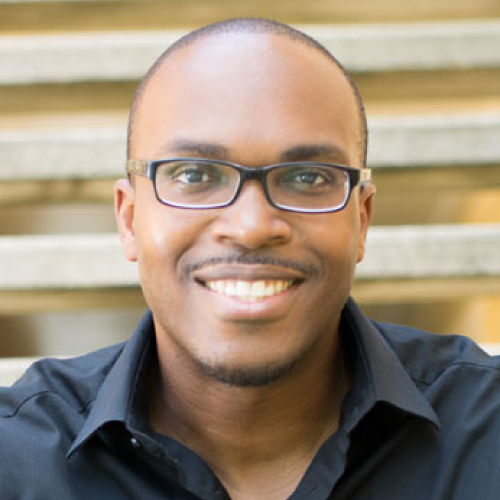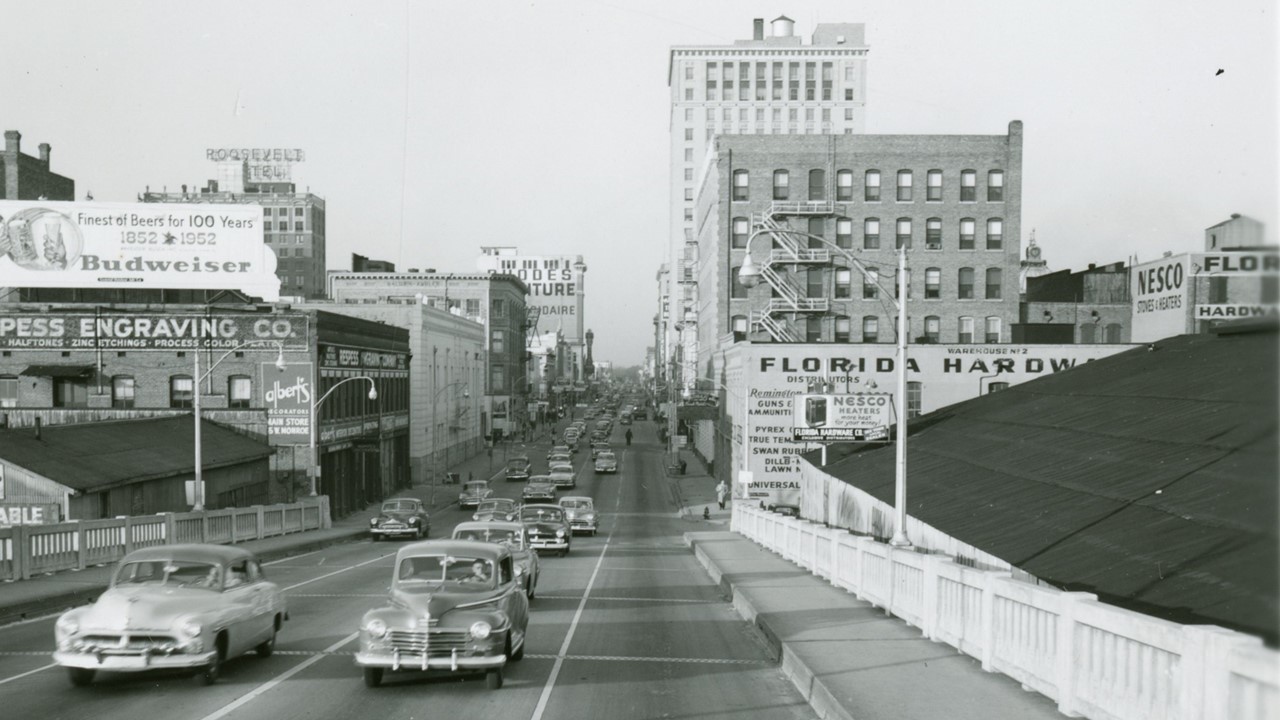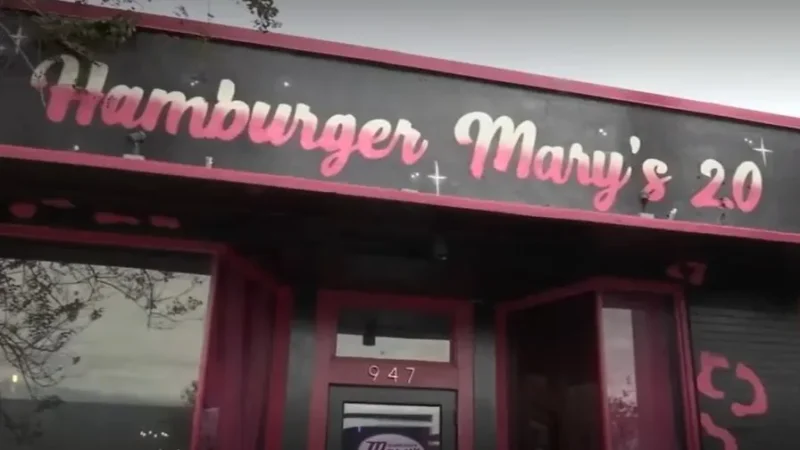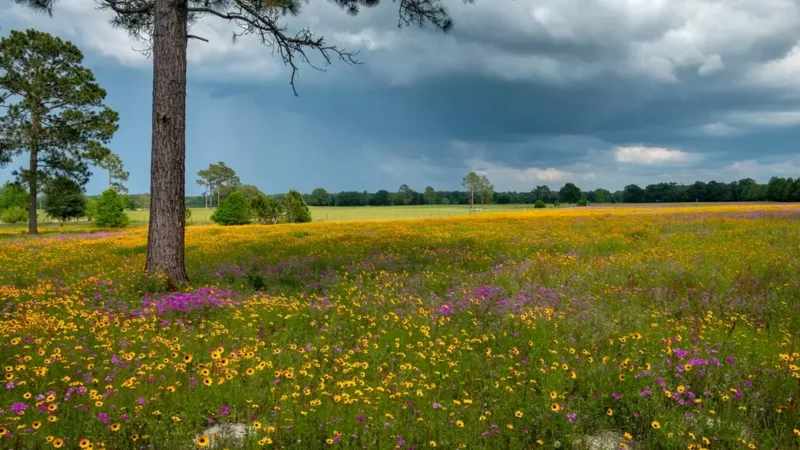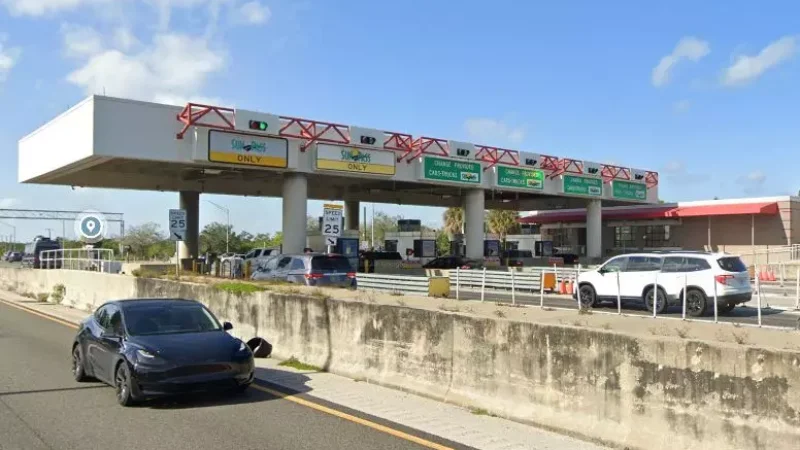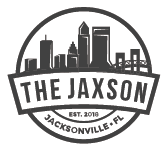
Once vital arteries of Jacksonville’s growth and cultural identity, here are four historic commercial corridors that have been forgotten and lost to time.
Downtown’s Main Street

On February 24, 1893, Jacksonville’s Main Street made history as the site of Florida’s first electric streetcar line, connecting Downtown Jacksonville to the growing neighborhood of Springfield. This pioneering infrastructure spurred rapid development, and after the Great Fire of 1901, Main Street emerged as a central artery in the city’s dramatic revitalization, symbolizing a modern and ambitious new Jacksonville.
As the city rebuilt, Main Street quickly evolved into a bustling retail corridor, drawing both residents and visitors. By the 1950s, it had transformed into a congested but vital thoroughfare, channeling thousands of commuters and shoppers through the heart of Downtown every day. According to the 1950 U.S. Census, Jacksonville was a dense, pedestrian-oriented city with a population of 204,275. The economy was robust, supported by 24,000 manufacturing jobs across 350 factories.
Main Street’s prominence extended to the Downtown waterfront, where the majority of the city’s 78 wharves and port terminals were located—particularly near the intersection of Main and Bay streets. The city’s key exports included iron and steel, lumber, millwork, naval stores, cotton, and wood pulp, while its imports included petroleum products, fertilizer materials, gypsum rock, bananas, green coffee and newsprint.
In this mid-century heyday, Main Street was also Jacksonville’s primary shopping street, home to major national chains such as S.H. Kress & Co., Woolworth, Lane Drugs, JCPenney, McCrory, and Grant’s. However, in the 1960s through the ’80s, Main Street’s role as a retail destination began to fade. The construction of Interstate 95 and the migration of commerce to suburban shopping malls contributed to its decline.
By the end of the 20th century, what had once been a vibrant urban streetscape, lined with diverse architecture and a rich mix of uses, was transformed into a one-way arterial “freeway.” The pedestrian-friendly corridor gave way to wide lanes, synchronized traffic lights, surface parking lots and garages, reflecting a broader shift in priorities from walkability to automobile convenience.

Fletcher Park’s Times Square

Nestled just east of San Marco Square, the Fletcher Park neighborhood was named in honor of Sen. Duncan U. Fletcher (1859–1936), a two-term mayor of Jacksonville and the longest-serving U.S. Senator in Florida’s history. Conceived as a streetcar suburb, the neighborhood was designed by renowned local architect Henry J. Klutho and constructed between July 1918 and April 1919. At its inception, it was heralded as “a model town” for its thoughtful planning and modern design.
By the time Fletcher Park was annexed into the City of Jacksonville in 1933, a bustling commercial district known as Times Square had emerged around the streetcar terminus at the intersection of Atlantic Boulevard and Kings Avenue. By 1950, Times Square had grown into a vibrant urban node stretching two blocks north and south along Kings Avenue from Landon Avenue to Olevia Street, and two blocks east and west along Atlantic Boulevard from Fulton Place to Truman Avenue.
However, Times Square’s prominence was short-lived. With the advent of I-95, much of the commercial district was demolished by 1960, erasing what had once been a cornerstone of neighborhood life and commerce.
One of the last remaining vestiges of Times Square is the building at 1944 Atlantic Blvd. Constructed in 1929, it was once the Daylight Supermarket and today serves as a location for Fresenius Medical Care. Meanwhile, the broader Fletcher Park neighborhood has retained much of its World War I-era housing, along with its historic scale, charm, and character, offering a glimpse into Jacksonville’s early 20th century suburban development.

LaVilla’s Broad Street

At its peak, Broad Street stood as a thriving center of Black economic empowerment, cultural expression and Civil Rights activism in Florida. Lined with Black-owned banks, insurance companies, restaurants, theaters, mutual aid societies, boarding houses, seafood markets, grocery stores, hotels, furniture stores and professional offices, the corridor was a vibrant hub of African American life and resilience.
Originally known as Bridge Street, it was renamed Broad Street during the 1920s. A defining moment in its history came in 1898, when Patrick Henry Chappelle opened the Excelsior Concert Hall at 132 Broad St., marking the establishment of the South’s first Black-owned theater. Two years later, in 1900, Chappelle launched the famed Rabbit’s Foot Co., a pioneering tent show that became a cornerstone of Southern vaudeville entertainment. Known affectionately as “The Foots,” the troupe toured extensively from 1900 into the late 1950s, headquartered in LaVilla prior to World War I.
Dubbed the “Black P.T. Barnum,” Chappelle was one of the largest Black employers in the entertainment industry. The Rabbit’s Foot Co. served as an early stage for future legends such as Ma Rainey, Bessie Smith, Ida Cox, Louis Jordan, and comedians Tim Moore and Butterbeans and Susie.
South of Adams Street, Broad Street’s businesses also served LaVilla’s red-light district and its Greek and Syrian immigrant communities. Meanwhile, Jacksonville’s Orthodox Jewish community established kosher butcher shops, clothing businesses and dry goods stores along the corridor. During an era of segregation—when Black residents were barred from entering Downtown Jacksonville—Broad Street became a crucial commercial lifeline for the African American community. Black restaurant owners along nearby Ashley and Davis streets were key patrons of many Broad Street markets.
Broad Street’s prominence declined following the end of segregation. Despite significant loss of building stock during recent decades, today Broad Street retains the highest concentration of surviving historic structures in LaVilla.

LaVilla’s Davis Street

Originally known as Second Street before LaVilla’s annexation into Jacksonville in 1887, Davis Street emerged as a vital commercial and cultural corridor following the devastating Great Fire of 1901. In the decades that followed, it flourished with hotels, restaurants, theaters, and retail businesses, becoming a centerpiece of Jacksonville’s Black business and cultural life.
A year after the fire, in 1902, the North Jacksonville Street Co., a Black-owned enterprise, began operating a streetcar line along Davis Street. This line, known locally as “The Colored Man’s Railroad,” linked the growing African American neighborhoods of Sugar Hill, Moncrief Park and Durkeeville, encouraging their expansion along the corridor. This early 20th century growth helped shape what is now recognized as Northwest Jacksonville.
Davis Street was home to several prominent Black-owned businesses and institutions, including Nick’s Pool Parlor, the Flagler Hotel, Boston Chop House, the Ritz Theatre and the Cookman Institute. Notably, in 1923, the Cookman Institute merged with Dr. Mary McLeod Bethune’s Daytona Literary and Industrial Training School for Negro Girls, eventually evolving into Bethune-Cookman University in Daytona Beach.

Davis Street’s prosperity began to decline after 1950, as it became a focal point for urban renewal and highway construction, including the building of I-95. Further transformation came in 1993 with the city of Jacksonville’s River City Renaissance plan. This initiative led to the demolition of a 50-block section of LaVilla, bounded by I-95, State, Broad and Forsyth streets. The current landscape of Davis Street, including institutions like the LaVilla School of the Arts, emerged largely as a result of this redevelopment.
